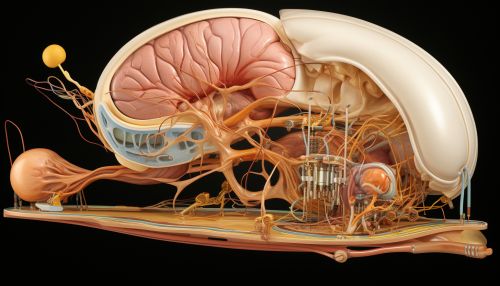Limbic System
Overview
The limbic system is a complex set of structures found in the brain that plays a key role in emotion, behavior, motivation, long-term memory, and olfaction. The term "limbic" comes from the Latin word "limbus," meaning "border" or "edge," as these structures form a border around the brainstem.
Anatomy
The limbic system is composed of several interconnected structures that work together to process and interpret sensory information and generate emotional responses. These structures include the amygdala, hippocampus, thalamus, hypothalamus, basal ganglia, cingulate gyrus, and olfactory bulb.


Amygdala
The amygdala is an almond-shaped structure located deep within the brain. It plays a crucial role in processing emotions, particularly fear and aggression. The amygdala is also involved in the formation of emotional memories.
Hippocampus
The hippocampus is a seahorse-shaped structure located within the medial temporal lobe. It is essential for learning and memory, particularly the formation of long-term memories.
Thalamus
The thalamus is a large mass of gray matter located in the center of the brain. It acts as a relay station, transmitting sensory information to the cerebral cortex.
Hypothalamus
The hypothalamus is a small region located below the thalamus. It plays a vital role in maintaining the body's homeostasis by regulating a variety of physiological processes, including temperature, hunger, thirst, sleep, and circadian rhythms.
Basal Ganglia
The basal ganglia are a group of structures located deep within the brain. They are involved in a variety of functions, including motor control, learning, and reward processing.
Cingulate Gyrus
The cingulate gyrus is a curved structure located within the cerebral cortex. It plays a role in processing emotions and behavior regulation.
Olfactory Bulb
The olfactory bulb is a structure located at the front of the brain. It is responsible for processing information related to smell.
Function
The limbic system plays a crucial role in the processing and regulation of emotions. It is also involved in the formation of memories, particularly those associated with emotions. The limbic system also plays a role in various other functions, including sensory perception, motor function, and homeostasis.
Emotion
The limbic system is often referred to as the "emotional brain" due to its significant role in processing emotions. The amygdala, in particular, is involved in the processing of fear and aggression, while the cingulate gyrus is involved in regulating emotional responses.
Memory
The limbic system, particularly the hippocampus, plays a crucial role in the formation of long-term memories. It is also involved in the consolidation of information from short-term memory to long-term memory.
Sensory Perception
The thalamus, a part of the limbic system, acts as a relay station for sensory information, transmitting it to the cerebral cortex for further processing.
Motor Function
The basal ganglia, a part of the limbic system, are involved in the control of voluntary motor movements.
Homeostasis
The hypothalamus plays a vital role in maintaining the body's homeostasis by regulating a variety of physiological processes.
Clinical Significance
Given its role in emotion and memory, the limbic system is implicated in a variety of neurological and psychiatric disorders. These include Alzheimer's disease, epilepsy, depression, anxiety disorders, and schizophrenia.
